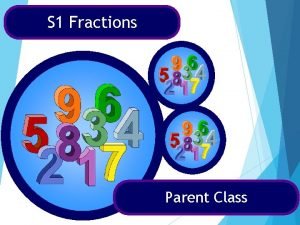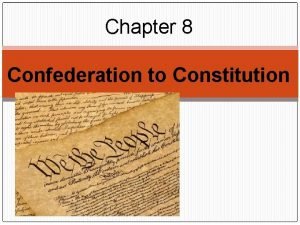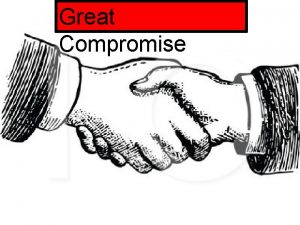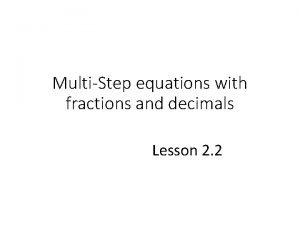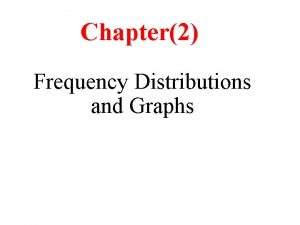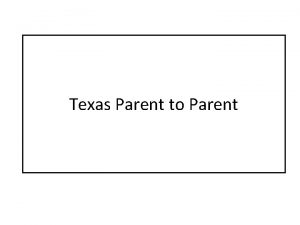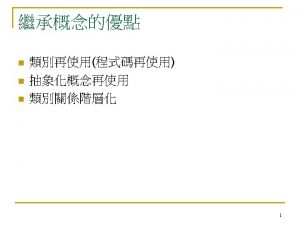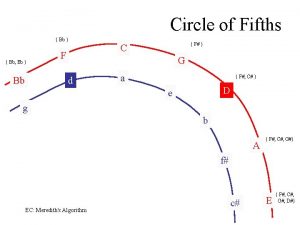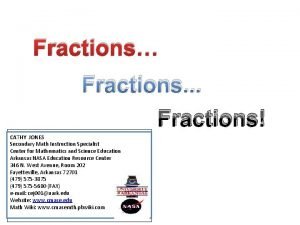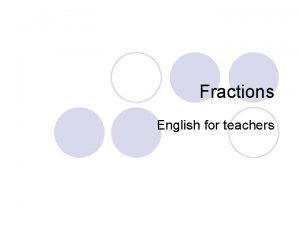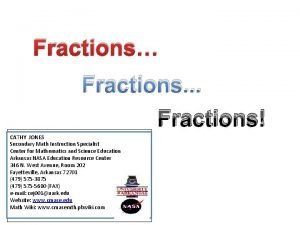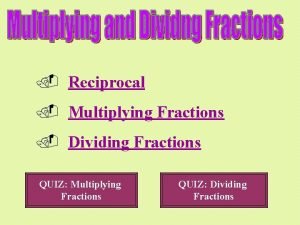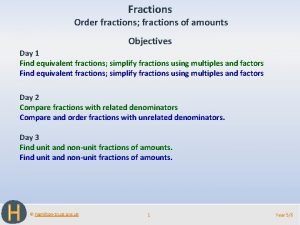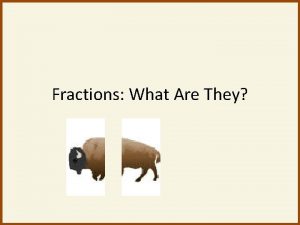S 1 Fractions Parent Class Fractions Two fifths
























- Slides: 24

S 1 Fractions Parent Class

Fractions Two fifths is written as: two parts 2 Numerator 5 Denominator out of five parts altogether 2 of 46

Fraction of an amount When we work out a fraction of an amount we divide by the denominator and multiply by the numerator Examples, 2 of 18 litres 3 = 18 ÷ 3 × 2 =6× 2 = 12 litres 3 of 46 5 of £ 24 6 = 24 ÷ 6 × 5 = 4× 5 = £ 20

Question Time (Question 1) 4 of 46

Simplifying fractions A fraction is said to be expressed in its lowest terms if the numerator and the denominator have no common factors. Which of these fractions are expressed in their lowest terms? 14 16 7 8 20 27 3 13 15 21 5 7 14 35 2 5 32 15 Fractions which are not shown in their lowest terms can be simplified by cancelling. 5 of 46

Question Time (Question 2) 6 of 46

Mixed and Improper Fractions When the numerator of a fraction is larger than the denominator it is called an improper fraction. 15 is an improper fraction or top heavy. 4 We can write improper fractions as mixed numbers. 15 can be visually shown as 4 15 ÷ 4 = 3 remainder 3 7 of 46 15 = 4 3 3 4

Improper fractions to mixed numbers 37 Convert to a mixed number. 8 37 8 8 + + + = 8 8 8 + 1+1+ 5 = 4 8 = 5 8 This number is the remainder. 37 ÷ 8 = 4 remainder 5 37 = 8 4 5 8 This is the number of times 8 divides into 37. 8 of 46

Mixed numbers to improper fractions Convert 3 2 = 7 3 2 to an improper fraction. 7 2 7 1+1+1+ 7 7 7 2 = + + + 7 7 23 = 7 To do this in one step, … and add this number … 3 2 23 = 7 7 Multiply these numbers together … 9 of 46 … to get the numerator.

Question Time (Question 3 & 4) 10 of 46

Multiplying Fractions 3 2 What is × ? 8 5 To multiply two fractions together, multiply the numerators together and multiply the denominators together: 3 3 12 4 = × 8 40 10 5 3 = 10 11 of 46

Multiplying Fractions What is 5 5 12 × ? 6 25 Start by writing the calculation with any mixed numbers as improper fractions. To make the calculation easier, cancel any numerators with any denominators. 35 7 12 2 14 × = 5 6 25 5 1 = 12 of 46 2 4 5

Question Time (Question 6) 13 of 46

Adding & Subtracting Fractions When fractions have the same denominator it is quite easy to add them together and to subtract them. For example, 3 5 + 1 5 = 3+1 = 5 4 5 We can show this calculation in a diagram: + 14 of 46 =

Adding & Subtracting Fractions 7 8 – 3 8 = 7– 3 8 = 4 1 8 2 = 1 2 Fractions should always be cancelled down to their lowest terms. We can show this calculation in a diagram: – 15 of 46 =

Adding & Subtracting Fractions 1 7 4 + + = 9 9 9 12 9 = 1 3 9 1 3 = 1 1 3 Top-heavy or improper fractions should be written as mixed numbers. 16 of 46

Adding & Subtracting Fractions 1 45 + 3 2 5 = 75 3 Add your whole numbers together and then your fractions. 17 of 46

Question Time (Question 5) 18 of 46

Fractions with different denominators are more difficult to add and subtract. For example, 1 1 What is + ? 2 3 We can show this sum using diagrams: + 3 6 19 of 46 + = 2 6 = 3+2 = 6 5 6

What is 3 1 + 4 3 1. Write each fraction over the lowest common denominator. × 3 3 1 × 4 + × 3 4 3 × 4 9 4 = + 12 12 2) Add the fractions together. 13 = 12 1 20 of 46

What is 2 3 + 5 4 1 3 1) Write each fraction over the lowest common denominator. 1 × 5 3 × 3 + 3 × 5 5 × 3 5 9 = + 15 15 2) Add the fractions together. 9 5 = + 15 15 14 = 15 2 2 6 6 21 of 46 4 4

What is 5 2 3 2 1 7 1) Write each fraction over the lowest common denominator. 5 = 5 2 × 7 3 × 7 1 × 3 7 × 3 2 21 14 21 2) Subtract the fractions together. 14 3 = 21 21 11 = 21 3 3 22 of 46

A problem with subtractions What about 23 of 46 9 1 5 - 2 3 4

Question Time (Question 7) 24 of 46
 Two fifths as a fraction
Two fifths as a fraction Four fifths rule
Four fifths rule Four fifths rule
Four fifths rule Three fifths compromise example
Three fifths compromise example 3 fifths of a man
3 fifths of a man Fifths disease rash stages
Fifths disease rash stages Circel of fifths
Circel of fifths Which best explains the need for the great compromise
Which best explains the need for the great compromise E class parent
E class parent Eclass parent app
Eclass parent app Multi step equations fractions
Multi step equations fractions Solving two step and multi step inequalities
Solving two step and multi step inequalities What about today's class
What about today's class Putting a package together
Putting a package together Difference between abstract class and concrete class
Difference between abstract class and concrete class Mode of grouped data
Mode of grouped data Class i vs class ii mhc
Class i vs class ii mhc Abstract concrete class relationship
Abstract concrete class relationship How to find class mark in frequency distribution
How to find class mark in frequency distribution Stimuli vs stimulus
Stimuli vs stimulus Response class vs stimulus class
Response class vs stimulus class 7 rights of medication administration in order
7 rights of medication administration in order Class maths student student1 class student string name
Class maths student student1 class student string name How to find class boundaries
How to find class boundaries In greenfoot, you can cast an actor class to a world class?
In greenfoot, you can cast an actor class to a world class?
